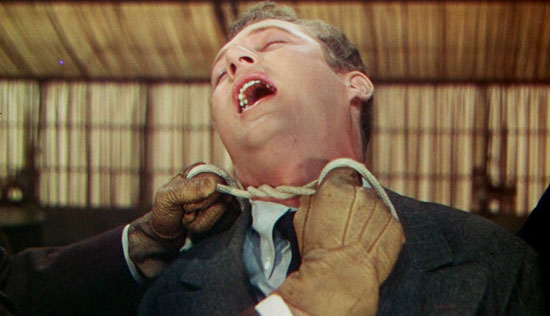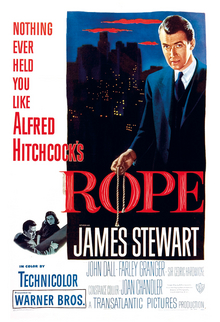this is the idea I had in my head of bob guarding the dressing room.
Thursday, 29 January 2015
Wednesday, 28 January 2015
Tuesday, 27 January 2015
Wednesday, 21 January 2015
Monday, 19 January 2015
Alfred Hitchcock's Rope (1948) Film Review
Figure 1: Movie poster.
Alfred Hitchcock’s Rope (1948) is an incredibly well shot film in which the minimalistic movements from the way the characters interact with the studio set create a real sense of suspense. Many films have attempted this but none have really quiet captured it as much as Hitchcock does in the film rope. The is an adaptation of Patrick Hamilton’s play, the film is about two young lovers who commit the perfect murder and celebrate the crime by throwing a party in which they have invited along many people who know and loved the victim, The people at the party are left wondering what the real occasion of having the party was and wondering were David was who was the victim of the murder.

Figure 2: The opening scene in which David is murdered.
Hitchcock is very clever in how he provokes a sense of suspense with the audience. The opening scene in which is the murder of young David sets the pace of the film and leaves the audience knowing that they are watching a film about two absolute egotistic psychos. Although the opening scene was chilling it was tense as it did have a build up to the murder which is highly unusual for a film. The parts which make the film tense is the fact that the camera is almost glued to were the body of David is hidden, Even when people have important things to say in which would have an impact with the story they were out of the shot leaving you to concentrate with how close David's loved ones were to discovering his body. In R Nathaniel's review of the film he comments on the tension through out the film saying "The amount of tension Hitchcock manages to build by doing so little is admirable." (Nathaniel, 2011).

Figure 3: The chest in which David's body was hidden and used as a table.
One of the key elements in what makes this film feel so intimate and very similar to its source being the play is that Hitchcock planned to shoot the film as one continuous shot. You can tell Hitchcock has done this by certain tactical moments of film making for example he would zoom into the back of character's jackets rather then cutting away in order to make the film feel smooth and fluid. Pamela Hutchinson also comments on the fluid motion of the film saying that "Rope feels "live", which means that at any minute one of the actors could do something unexpected, such as fluff their lines, or heaven forbid, open the trunk." (Hutchinson, 2012).

Figure 4: Still shot of the party celebrating David's death
Once the film has finished and the credits role you begin to reflect on what you have seen and look past the clever use of contentious shots and Hitchcock's artistic flare throughout the film and realise this is an incredibly dark and sinister film although it lacks blood and a sense of scare factor in other horrors and thrillers . The thought of some one who generally believes that murder should only be a crime for the weak and the poor is just simply inhuman and is more chilling and scarier then any typical slasher thriller and horror. Vincent Carnby also stated how dark the story line of this film is by saying ""Rope" is not exactly a picture to warm your heart, take your mom to or make out by."
Illustration List
Figure 1: http://upload.wikimedia.org/wikipedia/en/8/8e/Rope2.jpg
Figure 2: https://robertsnow.files.wordpress.com/2011/08/rope-murder.jpg
Figure 3: http://criticsloft.com/wp-content/uploads/2014/01/Rope-pic-1.jpg
Figure4: https://blogger.googleusercontent.com/img/b/R29vZ2xl/AVvXsEizhC9YkAE2FcuhHXi_QCHyiYzJBrWVt3aPcLE-Uz-CMZQXYiOP2-dBwEsY2myqdH1LbfDiAZDbzRwiVOAUffzwoJZyHoqaJ5B_ZyxNnoYEN06OL9f9SW7Pj8_P-jgExFbeMe5AA1GQL8g/s1600/Rope+janet+and+all.jpg
Bibliography
Nathaniel, R (22nd June 2011), The Film Experience, At:
http://thefilmexperience.net/blog/2011/6/22/personal-canon-100-rope.html
Hutchinson, P (27th July 2012), The Guardian review, At:
Canby, V (3rd June 1984), The New York Times review, At:
http://www.nytimes.com/library/film/060384hitch-rope-reflection.html
http://www.nytimes.com/library/film/060384hitch-rope-reflection.html
Sunday, 18 January 2015
Monday, 12 January 2015
Subscribe to:
Comments (Atom)
















